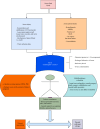Complex Limb Injuries: Limb Salvage Versus Amputation-A Mini Review and Meta-Analysis
- PMID: 39950183
- PMCID: PMC11824304
- DOI: 10.1155/aort/2884802
Complex Limb Injuries: Limb Salvage Versus Amputation-A Mini Review and Meta-Analysis
Abstract
Introduction: The management of complex limb injuries can be very challenging, and it demands a multidisciplinary approach to treatment. Amputation and limb reconstruction are the two options that clinicians must choose. This study aims to comprehensively synthesize existing tools and resources from the literature that can assist clinicians in the decision-making process. Evaluation: The initial resuscitation and the prehospital care are the first important steps in the management of these injuries, while the immediate transfer to trauma centers is recommended for complex cases. After the stabilization of the patient, a thorough clinical examination of the limb is necessary with emphasis on the degree of soft tissue damage. Blunt trauma in the lower limb is associated with a higher risk of early amputation. Polytrauma patients with complex limb injuries require a holistic approach, with Damage Control Orthopedics (DCO) principles. Traumatic bleeding significantly increases mortality rates, necessitating prompt control using pressure bandages or tourniquets. Computed tomography angiography (CTA) is necessary in order to assess the viability of the limb. Management: Scoring systems can be used as a tool in the management of complex lower and upper limb injuries. Mangled Extremity Severity Score (MESS) calculates ischemia, shock, bone and soft tissue damage, and patient characteristics. The Narakawa Index (NISSSA score) constitutes an alteration of MESS with the implementation of a nerve injury element. The Musculoskeletal Score for Severity of Injury (MESI score) estimates the risk of limb amputation by evaluating injury, neurovascular damage, type of fracture, patient characteristics, and the period from the occurrence of trauma to the definitive treatment. Further interventions and patient preferences should be incorporated into the decision-making process. Outcome: The outcomes of limb salvage versus amputation for complex limb injuries encompass various factors, including patient's preinjury health status, psychological well-being, functional outcomes, and economic impact. While some studies suggest better psychological outcomes with limb reconstruction and others find similar functional outcomes between the two approaches, economic considerations play a significant role in decision-making. Conclusion: Managing complex limb injuries effectively necessitates a comprehensive approach involving thorough assessment, multidisciplinary collaboration, and patient-centered care. Given the diverse factors influencing management and long-term outcomes, it is crucial to integrate medical expertise with patient preferences and expectations.
Copyright © 2025 Athanasios Serlis et al. Advances in Orthopedics published by John Wiley & Sons Ltd.
Conflict of interest statement
The authors declare no conflicts of interest.
Figures
References
Publication types
LinkOut - more resources
Full Text Sources




